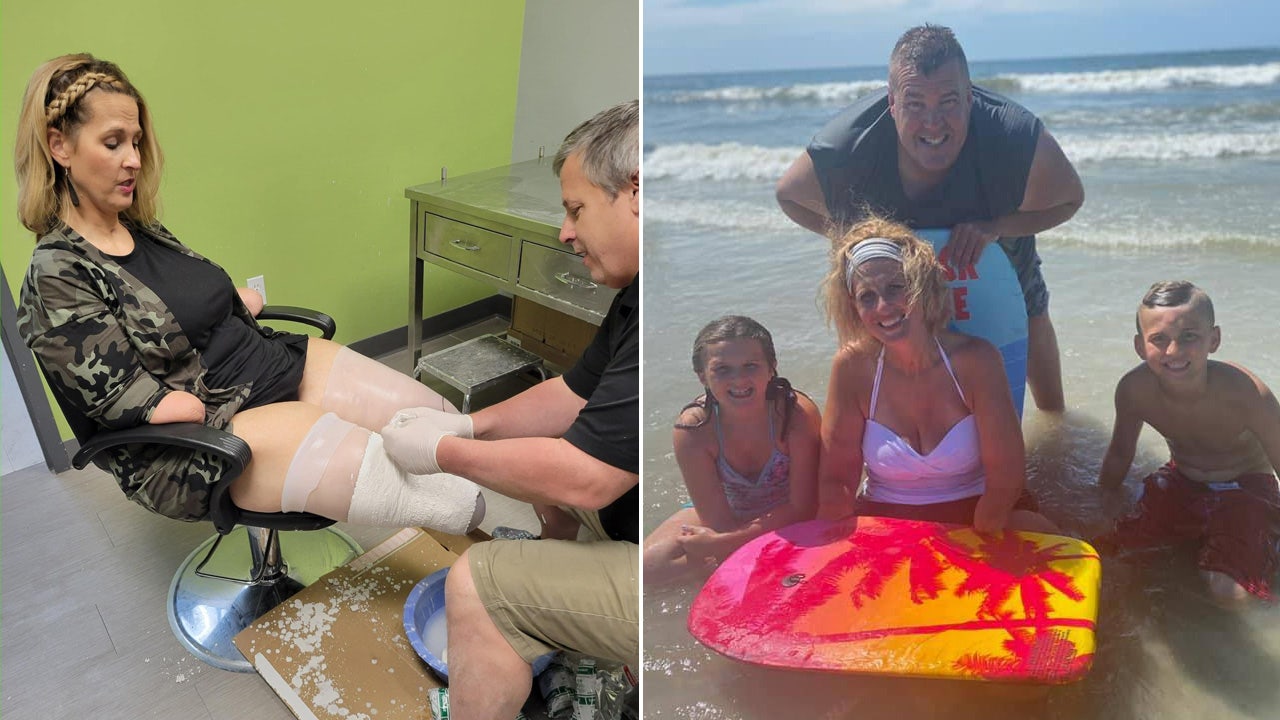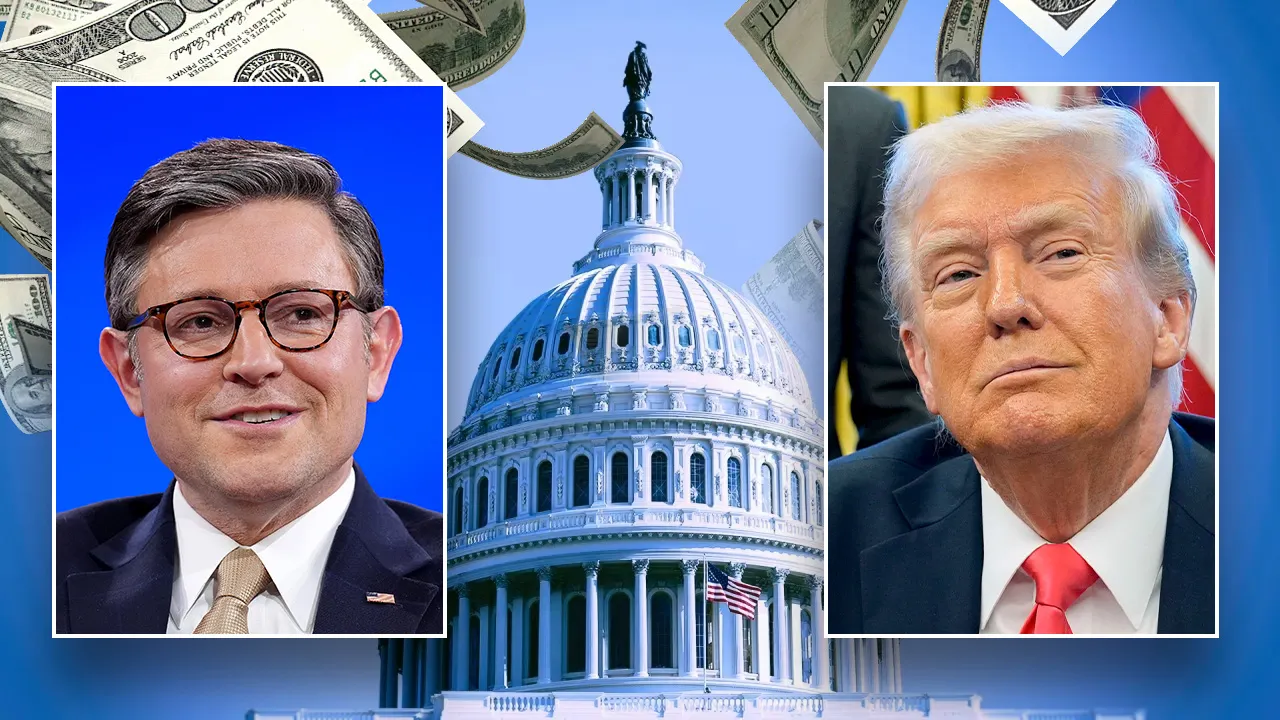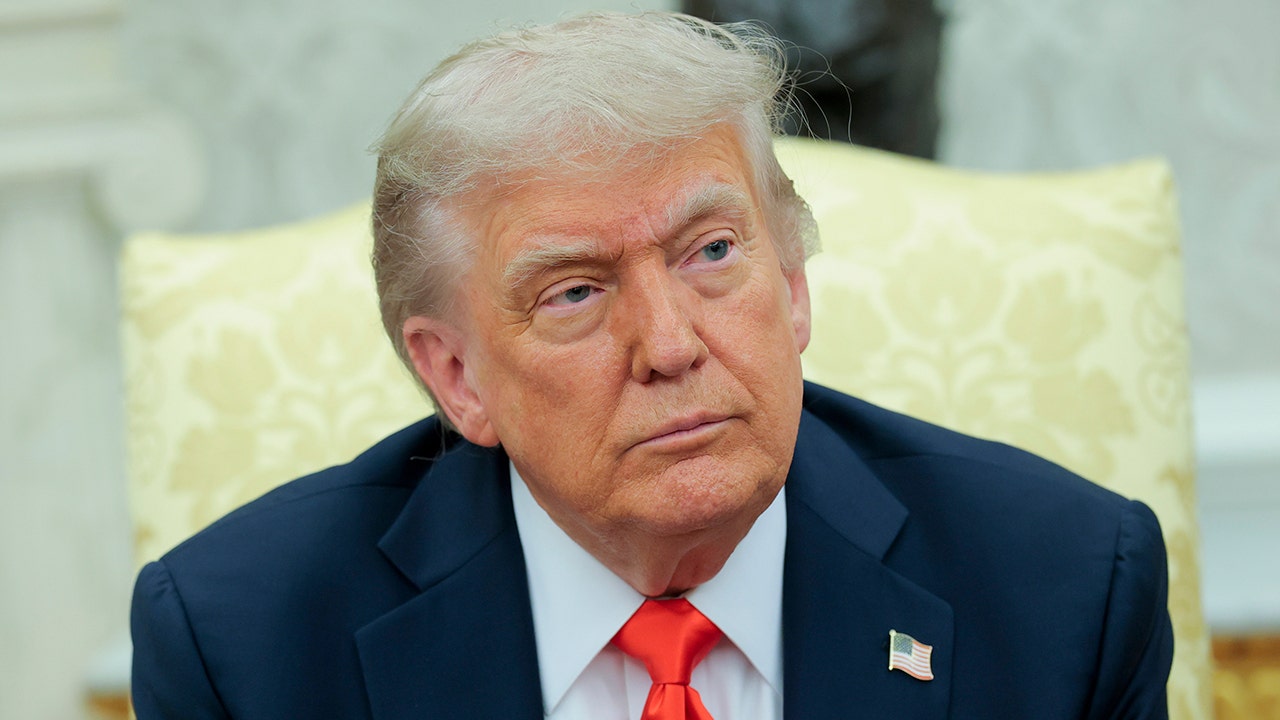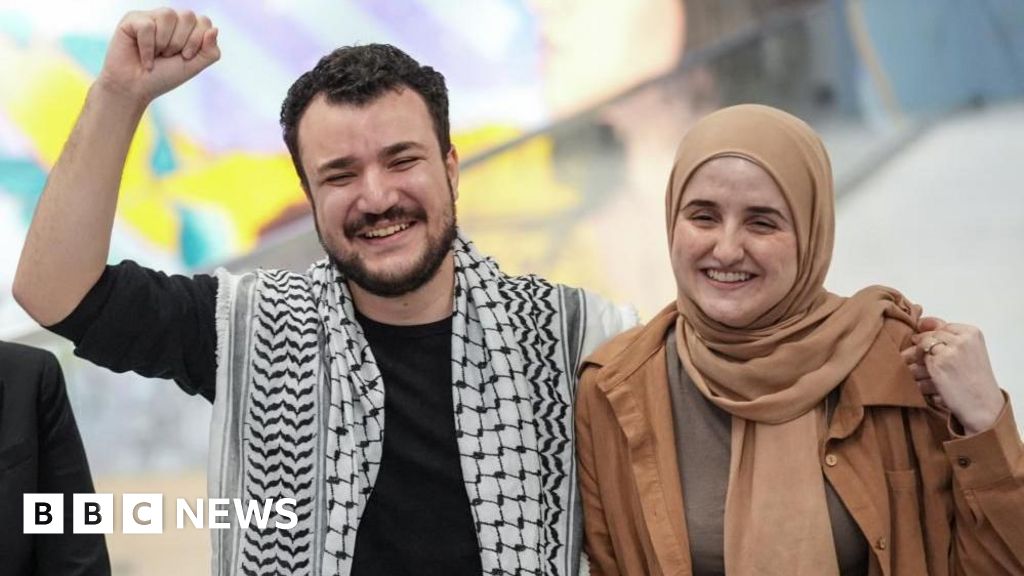Health
Ohio woman who lost all four limbs to flu complications speaks out to raise awareness

For most people, getting the flu means a few days of sickness and then a return to regular life. But for Kristin Fox, a 42-year-old mother and high-school principal in Ohio, the virus led to the loss of her arms and legs — and the start of a long, challenging journey to a new normal.
Fox’s ordeal began in March 2020, just a few days before the COVID-19 pandemic shut down the world.
She came down with a sore throat on Friday, and by Sunday she felt considerably worse. At urgent care that night, she tested positive for the flu.
AFTER LOSING HER LEG TO THE FLU, VIRGINIA WOMAN URGES PEOPLE TO GET VACCINATED: ‘DON’T WASTE TIME’
The physician’s assistant gave her Tamiflu and sent her home. The next day, Fox couldn’t get off the couch.
“I felt like I was dying,” she told Fox News Digital during a phone interview.
For Kristin Fox, a 42-year-old mother and high-school principal in Ohio, the flu led to the loss of her arms and legs — and the start of a long and challenging journey to a new normal. (Kristin Fox)
A nurse friend came over to take Fox’s blood pressure and oxygen levels, both of which were dangerously low.
Fox’s friend drove her to a small nearby hospital.
“Within 30 minutes, I was on a ventilator, and they said I probably wouldn’t make it,” Fox said.
She had developed bacterial pneumonia, which was leading to organ failure. Fox’s kidneys were shutting down and one of her lungs had collapsed.
What the medical team apparently didn’t realize, Fox said, was that she was already in septic shock, which is a life-threatening infection that causes organ failure and plummeting blood pressure.
GETTING SEPSIS IN THE HOSPITAL IS A RED FLAG FOR FUTURE HEART ATTACKS, STUDY FINDS
By Tuesday night, the hospital brought in a priest, expecting that Fox wouldn’t make it through the night — “but by the grace of God, I did,” she said.
By Thursday, doctors realized Fox was septic, she said. She was put into a medically induced coma and given vasopressor drugs in an attempt to save her vital organs.

Fox is pictured with her son, Landon, and her daughter, Laiken. (Kristin Fox)
“The doctors told my family they should prepare for the loss of some fingers or toes, because they were pulling so much from my extremities to try to keep my organs alive,” Fox said.
A couple of days later, the world shut down due to the pandemic — but because Fox was deemed the most critical patient in the hospital, they allowed her parents and husband to stay with her.
“It was touch and go for the next week,” Fox said.
Each year, at least 1.7 million adults in the U.S. develop sepsis, and nearly 270,000 die from the infection.
On March 26, the doctors told Fox’s husband and parents that they would have to amputate her legs the following day.
Fox’s mother begged the doctors to wait a few more days to see if she got better — but they said if they held off any longer, the infection would continue to rise above Fox’s knees, making her quality of life substantially worse, Fox related.
TEXAS MOM SUFFERS QUADRUPLE AMPUTATION, CREDITS HER FAITH AND A LITTLE DOG FOR PULLING HER THROUGH
The next day, Fox’s legs were amputated below her knees.
In the days after that first surgery, Fox’s arms got excessively worse, she said — “but they waited and didn’t take my arms until April 6, almost two weeks later.”
Fox considers it “lucky” that her arms were amputated just below the elbow, so she still has that range of motion — although it’s still very short compared to amputees who only lose their hands.
Within 72 hours, Fox was able to breathe without a ventilator and was transferred out of the ICU and into a “step-up room.”
After the surgeries, Fox was slowly brought out of her coma. “I was so confused,” she said. “I was still on a ventilator. I had no idea what was going on in the world (with COVID).”
Even so, within 72 hours, Fox was able to breathe without a ventilator and was transferred out of the ICU and into a “step-up room.”
A few weeks later, on May 17, she left the hospital.
COLD AND FLU SEASON IS COMING: KNOW THE WARNING SIGNS AND SYMPTOMS NOW
“They literally wrapped me like a mummy because I didn’t want my kids to see — I hadn’t told them yet about losing my arms and legs,” she recalled.

Fox (second from left) is pictured with her lifelong best friends. (Kristin Fox)
Eventually, Fox told her son and daughter — who were 9 and 6 at the time — what had happened.
“Between that and COVID, it was so much for little kids to wrap their minds around.”
The next stop was the University of Pittsburgh Medical Center Rehabilitation Institute to start physical therapy.
“I knew it was the best place to go,” Fox said. “I had to go somewhere that was going to really kick my butt in therapy.”
COVID-19, FLU AND RSV VACCINES ARE ALL AVAILABLE THIS FALL: SEE WHAT SOME DOCTORS RECOMMEND AND WHY
In Pittsburgh, Fox completed six weeks of intense physical therapy, three hours per day.
Along the way, there were some setbacks — back at home, her lung collapsed again, and doctors had to put in a chest tube. Then she returned to Pittsburgh for six more weeks of therapy.
In October 2020, seven months after her ordeal began, Fox received prosthetics for her arms and legs, marking the beginning of a brand new journey.
“It was a huge learning curve,” she told Fox News Digital. “It was like trial and error of what worked and what didn’t.”
Last fall, Fox connected with an organization called 50 Legs in Orlando, Florida, which selects amputees who will receive custom prosthetics tailored to each patient’s body. After applying, she was selected and made the trip to get fitted for new, custom-made prosthetics — for free.

Fox is pictured with her family at her first annual softball tournament, which helped to raise funds for her care. (Kristin Fox)
“It has been life-changing, because they are truly built for me and not just a size that everybody wears,” she said. “Anytime I need something, they ship it to me, or they put me on a plane to come down for a quick fix.”
She added, “They’re just the most incredible people I have ever encountered.”
These days, Fox uses only the prosthetic legs.
“I don’t use the arms at all,” she said. “I’ve learned to live without them — it’s easier. I even drive without them.”
Embracing a ‘new normal’
As a quadruple amputee, Fox faces new challenges in navigating the world, everything from working out to going to football games.
“There are just different things I never thought about before, in terms of accessibility and compliance,” she said. “The people who make the legislation don’t sit in the seat very often.”

Fox is pictured with her husband and children. She said her family motivated her to keep moving forward. (Kristin Fox)
After a year away from work, Fox was ready to return to her job as assistant principal at Campbell High School.
“I mentally had to go back to work,” she said. “I’m a very ‘go, go, go’ type of person. And if I went out on disability, I was not going to have a good quality of life.”
Fox said her children and her students at school also motivated her to keep moving forward.
FLU PREVENTION TIPS FROM FLORIDA’S SURGEON GENERAL: A ‘DAY-TO-DAY’ HEALTHY LIFESTYLE IS KEY
“I had a lot of young eyes watching me, and I knew there were so many kids who would learn so much from my reaction to this,” she said.
“It’s taught them about respecting differences and treating everyone fairly, regardless of their ability,” Fox noted. “And it’s taught them how they should overcome their own barriers and tough moments.”
One of Fox’s favorite mantras, she said, is “I’ve never had a tough day — I have tough moments.”
She noted, “As an educator, I didn’t want my students to think I took the easy way out.”
“Sometimes I catch myself complaining, but then I remind myself that my kids could have been mourning my death.”
Back at work, Fox said her school has “moved mountains” to make the transition as easy as possible for her.
Fox’s co-principal, Brad Yeager, shared with Fox News Digital how impressed he’s been by her triumph over adversity.
“No matter what obstacles she has faced, she has always stayed the course as not only an educational leader, but as a mother,” he said.
“She has taken this challenge head-on and has never let it come between her and her students,” Yeager went on. “She exemplifies perseverance … Our students look up to her and realize that no matter how tough their situation is, that is not an excuse to not give it their all each and every day.”
Beacons of support
Fox’s lifelong best friend, Lisa Saxon, and her sister, Lauren Baco, are among Fox’s biggest champions.
“Not many people can say their best friend is a real-life hero, but I can — and Kristin continues to defy the odds every day,” Saxon told Fox News Digital.

Fox’s prosthetics company made her a customized mold for her toothbrush to go onto the residual limb of her arm. (Kristin Fox)
“Coming out of this as a quadruple amputee was life-changing, but it has only made her and everyone around her stronger.”
Baco cited a quote that reflects what her sister has gone through: “You never know how strong you are until being strong is all you have left.”
Baco added, “Kristin has shown every day how strong and resilient she is, taking on the day as if she has no limits or barriers.”
DOCTORS URGE VACCINATIONS AHEAD OF THIS YEAR’S FLU SEASON, WHICH COULD BE ‘FAIRLY BAD,’ EXPERTS SAY
The Youngstown community has rallied around Fox, organizing multiple fundraisers to help with her very steep medical expenses. Although insurance has covered some of her care, the out-of-pocket costs have been high — and there have also been expensive renovations to make the family’s home more accessible.
“Youngstown is not rich, but when something like this happens to somebody, they find ways to help,” she said. “That’s part of small-town pride.”

Fox is pictured with her family at her surprise 40th birthday party, one year and one month after the day she first got sick. (Kristin Fox)
“People send me stuff and stop me in the store and say, ‘I pray for you all the time,’” she added. “Those are the people who got us through.”
Overall, Fox said her ordeal has wholly shifted her perspective.
“Sometimes I catch myself complaining, but then I remind myself that my kids could have been mourning my death,” she said.
“They’re 12 and 10 now, and I can’t imagine them living without me.”
What to know about sepsis risk
Each year, at least 1.7 million adults in the U.S. develop sepsis, and nearly 270,000 die from the infection, according to the Centers for Disease Control and Prevention (CDC).
Dr. Marc Siegel, clinical professor of medicine at NYU Langone Medical Center and a Fox News medical contributor, called the flu “a great enabler” of more severe illness.
“A bacterial secondary infection is very common, upwards of 20% to 30%,” he told Fox News Digital. “This can be anything from a sinus infection to bronchitis, meningitis or pneumonia.”

Kristin Fox is pictured with her daughter, Laiken. (Kristin Fox)
The flu can cause an inflammatory response called a cytokine storm, the doctor noted, which interferes with the body’s ability to fight off a subsequent bacterial infection.
“If bacterial pneumonia goes undiagnosed for awhile, sepsis can occur, as the bacteria spreads to the bloodstream,” Siegel warned.
CLICK HERE TO SIGN UP FOR OUR HEALTH NEWSLETTER
“If blood pressure drops too low, blood flow to the extremities drops off and tissue can die, leading to the need for amputation.”
Although the secondary bacterial infection is common, it is “very uncommon” for it to lead to sepsis, Siegel said.
Warning signs of sepsis include high fever, fatigue, dizziness and weakness.
To help prevent limb loss, Siegel said it’s important to get the patient to the hospital quickly and to start broad-spectrum antibiotics.

Fox is pictured on the day she gave the commencement address at her alma mater, Youngstown State University, in May 2021. (Kristin Fox)
“When the source of the infection is confirmed, use vasopressors to clamp down on arteries to preserve blood flow to vital organs and increase blood pressure,” he recommended.
Doctors should also monitor the extremities and levels of serum lactate, which measures the amount of lactic acid in the blood.
These levels can go up if the body’s tissues are not getting enough oxygen, Siegel said.
Fox said she hopes her story can help people — not only patients, but also the medical community — to be more aware of the signs of sepsis.
“I can’t go back and change [things],” she said. “I can only hope to be an advocate for the future.”
For more Health articles, visit www.foxnews.com/health.

Health
Grandfather's simple changes reversed pre-diabetes diagnosis that left him 'petrified'

NEWYou can now listen to Fox News articles!
A 66-year-old grandfather who exercised daily was stunned to learn he was pre-diabetic — and he says making one small change to his eating habits helped reverse it.
Dance teacher Will McKechnie, from Lytham St Annes, Lancashire, told SWNS he had always considered himself healthy.
At 5 feet 10 inches tall and 167 pounds, he wore a medium-sized shirt, danced seven times a week, and didn’t think twice about his daily snacks: a chocolate bar and a bag of chips.
EXPERTS REVEAL HIDDEN WAYS SUGAR ACCELERATES AGING BEYOND JUST WEIGHT GAIN
“I honestly thought I was really fit and healthy,” McKechnie said.
But after undergoing a free screening for people over 60 in May 2023, a routine blood test showed that his average blood sugar level was 6.2% — an indicator of pre-diabetes, according to SWNS.
Will McKechnie (right), a 66-year-old grandfather who exercised daily, was stunned to learn he was pre-diabetic. (William Mckechnie / SWNS)
McKechnie didn’t find out until a year later, during an unrelated appointment, when his doctor reviewed the results.
“I was so shocked and worried to hear I was pre-diabetic,” he said.
‘I’M A NEUROLOGIST — HERE’S WHY DEMENTIA IS RISING AND HOW TO REDUCE YOUR RISK’
McKechnie continued, “When he said it wouldn’t be reversible over 48, I was terrified. I was petrified at the idea that I might be starting to have poor health.”
Determined to turn things around, McKechnie made some major changes — not only in what he ate, but how.

McKechnie, determined to turn things around, made some major changes, such as cutting out nightly chocolate and chips and eating whole, nutritious foods instead. (iStock)
He cut out the nightly chocolate and chips, started eating whole, nutritious foods, and began chewing his food much more slowly.
Now, his lunch — a wholemeal chicken sandwich — takes him 40 minutes to eat.
“I just have a very occasional treat now, and much smaller,” McKechnie told SWNS.
GOLFER PHIL MICKELSON’S STRICT WEIGHT LOSS DIET: DOCTOR SHARES WHAT TO KNOW
His breakfast now consists of fruit, and a typical dinner includes boiled eggs, roasted peanuts, celery, cherry tomatoes, carrots and cucumber.
By focusing on slower eating and more mindful food choices, McKechnie shed nearly 27 pounds, bringing him down to 142 pounds and a size small shirt.
“I honestly thought I was really fit and healthy.”
He also lost two inches off his waist — and, more importantly, his blood sugar dropped to 5.9% within nine months, SWNS reported.
“I’m very determined,” McKechnie said.

McKechnie (pictured above doing a plank) shed nearly 27 pounds, bringing him down to 142 pounds and a size small shirt. (William Mckechnie / SWNS)
He added, “If I set my mind to doing something, I’ll do it, and I’m going to get my blood sugar even lower.”
The grandfather of four said he no longer battles sugar cravings and doesn’t feel the urge to rush into stores for a chocolate fix.
He also stays busy caring for his 18-month-old grandson and teaching two dance classes a week.

“Even if you have to pay for it, it’s worth getting your blood sugar checked routinely,” said McKechnie. (iStock)
McKechnie, who quit smoking in 1986 and stopped drinking in 2012, believes everyone should be proactive about checking their health — even if they look healthy on the outside.
CLICK HERE TO SIGN UP FOR OUR HEALTH NEWSLETTER
“Even if you have to pay for it, it’s worth getting your blood sugar checked routinely,” he told SWNS, adding, “It’s much, much better to find out.”
For more Health articles, visit www.foxnews.com/health
According to SWNS, McKechnie now says he feels stronger than ever and has “enormous amounts of energy.”
“I’m so relieved I had that test. It has changed my life and made me so much fitter.”
Health
Eating more fruits and vegetables linked to surprising effect on sleep

NEWYou can now listen to Fox News articles!
Your daily meal selections could influence the quality of your sleep, new research says.
A study from the University of Chicago Medicine and Columbia University found that increasing your intake of fruits and vegetables could help promote more restful sleep.
Previous research has shown that people who lack quality sleep may be more likely to indulge in unhealthy foods that are high in fat and sugar — and now this new finding sheds more light on how consumed foods impact sleep.
COUPLES WHO CUDDLE BEFORE SLEEP REAP KEY HEALTH BENEFITS, STUDY REVEALS
In the small study — which was published in “Sleep Health: The Journal of the National Sleep Foundation” — 34 healthy young adults reported their daily food consumption and wore a tracker to measure how often they woke up or changed sleep patterns during the night, according to a press release.
Those who reported eating more fruits and vegetables during the day were found to have “deeper, more uninterrupted sleep.”
A study from the University of Chicago Medicine and Columbia University found that increasing your intake of fruits and vegetables could help promote more restful sleep. (iStock)
Greater amounts of healthy carbohydrates, like whole grains, were found to have that same benefit, the study found.
“Dietary modifications could be a new, natural and cost-effective approach to achieve better sleep,” said co-senior author Esra Tasali, MD, director of the UChicago Sleep Center, in the release.
HOW TO CHOOSE THE BEST SLEEPING POSITION FOR YOU, ACCORDING TO THE EXPERTS
“The temporal associations and objectively-measured outcomes in this study represent crucial steps toward filling a gap in important public health knowledge.”
Based on the study findings, the researchers concluded that people who eat at least five cups of fruits and veggies per day could have a 16% increase in quality of sleep compared to those who eat none of those foods.
“Small changes can impact sleep. That is empowering — better rest is within your control.”
“16 percent is a highly significant difference,” Tasali said in the release. “It’s remarkable that such a meaningful change could be observed within less than 24 hours.”
“Based on current data, the experts confidently advise that regularly eating a diet rich in complex carbohydrates, fruits and vegetables is best for long-term sleep health,” the release stated.

Those who reported eating more fruits and vegetables during the day were found to have “deeper, more uninterrupted sleep.” (iStock)
The American Heart Association provides the following examples of fruit and veggie servings that equate to 1 cup of produce.
- 8 large strawberries
- 1 large bell pepper
- 1 medium potato
- 22 grapes
- 2 medium carrots or 12 baby carrots
- 1 medium apple, orange, pear, peach, grapefruit or nectarine
Dr. Chelsie Rohrscheib, head sleep expert at Wesper in Michigan, said that most sleep professionals recognize that a healthy diet supports overall well-being, including sleep quality — “so the findings of this study are not entirely unexpected.”
“However, it’s important to note that this was a relatively small study composed primarily of young adult male participants, which limits generalizability,” Rohrscheib, who was not involved in the study, told Fox News Digital.
CLICK HERE TO SIGN UP FOR OUR HEALTH NEWSLETTER
“While the results were statistically significant, the overall reduction in sleep fragmentation was modest, about 16%.”
The study was also observational in nature, she noted, which means it lacked the control of a randomized trial.

“Based on current data, the experts confidently advise that regularly eating a diet rich in complex carbohydrates, fruits and vegetables is best for long-term sleep health,” the researchers wrote. (iStock)
“Ideally, future research would compare a group consuming a fruit- and vegetable-rich diet to a control group with limited intake to better establish causality,” the doctor added.
The researchers plan to conduct more studies to confirm that eating produce causes better sleep and to determine the “underlying mechanisms of digestion, neurology and metabolism” driving this impact, the release stated.
For more Health articles, visit www.foxnews.com/health
“People are always asking me if there are things they can eat that will help them sleep better,” said co-senior author Marie-Pierre St-Onge, PhD, director of the Center of Excellence for Sleep & Circadian Research at Columbia, in the release.
“Small changes can impact sleep. That is empowering — better rest is within your control.”
Health
Bill Gates reveals 'next phase of Alzheimer's fight' as he shares dad's personal battle

NEWYou can now listen to Fox News articles!
Bill Gates is speaking out about his personal experience with Alzheimer’s — and his hope for progress in fighting the disease.
In an essay published this week on his blog at GatesNotes.com, the Microsoft co-founder and tech billionaire, 69, reflected on the difficulty of spending another Father’s Day without his dad, Bill Gates Sr.
The elder Gates passed away in 2020 at the age of 94 after battling Alzheimer’s.
RATES OF DEMENTIA ARE LOWER IN PEOPLE WHO EAT THIS SPECIFIC DIET, RESEARCH SHOWS
“It was a brutal experience, watching my brilliant, loving father go downhill and disappear,” Gates wrote in the blog post.
Today, motivated by his own experience with the common dementia, Gates — who serves as chair of the Gates Foundation — is committed to working toward a cure for the common dementia, which currently affects more than seven million Americans, or one in nine people over 65.
Bill Gates and Bill Gates Sr. pose in a meeting room at the Seattle headquarters of the Bill & Melinda Gates Foundation in 2008. (Gates Ventures)
In his blog, Gates expressed optimism about the “massive progress” being made in the fight against Alzheimer’s and other dementias.
Last year, Gates said he visited Indiana University’s School of Medicine in Indianapolis to tour the labs where teams have been researching Alzheimer’s biomarkers.
BILL GATES LIKELY HAD AUTISM AS A CHILD, HE REVEALS: ‘WASN’T WIDELY UNDERSTOOD’
“I also got the opportunity to look under the hood of new automated machines that will soon be running diagnostics around the world,” he wrote. “It’s an exciting time in a challenging space.”
One of the biggest breakthroughs in Alzheimer’s research, according to Gates, is blood-based diagnostic tests, which detect the ratio of amyloid plaques in the brain. (Amyloid plaques, clumps of protein that accumulate in the brain, are one of the hallmarks of Alzheimer’s.)

Bill Gates Jr. (right) poses with his father at his graduation ceremony in 1973. (Gates family)
“I’m optimistic that these tests will be a game-changer,” Gates wrote.
Last month, the U.S. Food and Drug Administration (FDA) approved the first blood-based test for patients 55 years and older, as Fox News Digital reported at the time.
“A simple, accurate and easy-to-run blood test might one day make routine screening possible.”
Traditionally, Gates noted, the primary path to Alzheimer’s diagnosis was either a PET scan (medical imaging) or spinal tap (lumbar puncture), which were usually only performed when symptoms emerged.
The hope is that blood-based tests could do a better job of catching the disease early, decline begins.

The Gates family poses for a photo in 1965. The elder Gates passed away in 2020 at the age of 94 after battling Alzheimer’s. (Gates family)
“We now know that the disease begins 15 to 20 years before you start to see any signs,” Gates wrote.
“A simple, accurate and easy-to-run blood test might one day make routine screening possible, identifying patients long before they experience cognitive decline,” he stated.
Gates said he is often asked, “What is the point of getting diagnosed if I can’t do anything about it?”
To that end, he expressed his optimism for the future of Alzheimer’s treatments, noting that two drugs — Lecanemab (Leqembi) and Donanemab (Kisunla) — have gained FDA approval.
“Both have proven to modestly slow down the progression of the disease, but what I’m really excited about is their potential when paired with an early diagnostic,” Gates noted.

Alzheimer’s disease currently affects more than seven million Americans, or one in nine people over 65. (iStock)
He said he is also hopeful that the blood tests will help speed up the process of enrolling patients in clinical trials for new Alzheimer’s drugs.
To accomplish this, Gates is calling for increased funding for research, which often comes from federal grants.
CLICK HERE TO SIGN UP FOR OUR HEALTH NEWSLETTER
“This is the moment to spend more money on research, not less,” he wrote, also stating that “the quest to stop Alzheimer’s has never had more momentum.”
“There is still a huge amount of work to be done — like deepening our understanding of the disease’s pathology and developing even better diagnostics,” Gates went on.
“I am blown away by how much we have learned about Alzheimer’s over the last couple of years.”
Gates pointed out that when his father had Alzheimer’s, it was considered a “death sentence,” but that is starting to change.
“I am blown away by how much we have learned about Alzheimer’s over the last couple of years,” he wrote.
For more Health articles, visit www.foxnews.com/health
“I cannot help but be filled with a sense of hope when I think of all the progress being made on Alzheimer’s, even with so many challenges happening around the world. We are closer than ever before to a world where no one has to watch someone they love suffer from this awful disease.”
-

 Arizona3 days ago
Arizona3 days agoSuspect in Arizona Rangers' death killed by Missouri troopers
-

 Technology1 week ago
Technology1 week agoGoogle is shutting down Android Instant Apps over ‘low’ usage
-

 Education1 week ago
Education1 week agoOpinion | Artificial intelligence, Trump and the Future: 13 Gen Z-ers Discuss
-

 Culture1 week ago
Culture1 week agoSlow and Steady, Kay Ryan’s “Turtle” Poem Will Win Your Heart
-

 News1 week ago
News1 week ago‘No Kings’ demonstrators to gather across Greater Cincinnati in opposition to Trump
-

 News6 days ago
News6 days agoAt Least 4 Dead and 4 Missing in West Virginia Flash Flooding
-

 Politics1 week ago
Politics1 week agoFate of Trump's $9.4 billion spending cut package hangs on House GOP moderates
-

 News1 week ago
News1 week agoHow Many Law Enforcement Agencies Are Involved in LA Immigration Protests?














